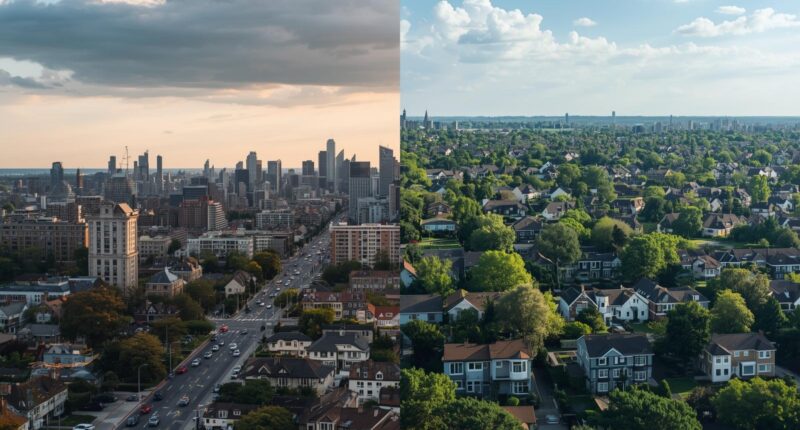From City Buzz to Suburban Calm: Finding Your Ideal Lifestyle
The Modern Lifestyle Dilemma
In today’s fast-paced world, choosing where and how to live has become a personal journey of balance.
Some people thrive in the vibrant energy of city life, surrounded by culture, nightlife, and opportunity. Others long for the peaceful rhythm of suburban living, where space, nature, and calm rule the day.
Whether you’re chasing a better work-life balance, seeking financial freedom, or planning a family-friendly home, understanding your ideal lifestyle is essential.
This article explores how to move from city buzz to suburban calm — and how to find the perfect middle ground for your personal goals and financial future.
The Evolution of Lifestyle Preferences
Lifestyle choices have evolved significantly over the last decade.
The rise of remote work, changing priorities, and global uncertainty have inspired millions to reconsider where they live.
Key Trends in Lifestyle Shifts
-
Remote and hybrid work models have made suburban and rural living more appealing.
-
Younger generations value quality of life over convenience.
-
Real estate affordability plays a major role in relocation decisions.
-
Many are seeking eco-friendly, community-based living environments.
Your choice of environment — city, suburb, or somewhere in between — shapes not only your daily comfort but also your financial stability and happiness.
Table – Comparing City vs. Suburban Lifestyle
| Aspect | City Lifestyle (Buzz) | Suburban Lifestyle (Calm) |
|---|---|---|
| Pace of Life | Fast, energetic, always active | Slower, relaxed, family-oriented |
| Housing Cost | Higher rent or property prices | More affordable for larger spaces |
| Commuting | Shorter distance but higher stress | Longer distance but less congestion |
| Social Scene | Vibrant nightlife and events | Local community gatherings and family time |
| Green Spaces | Limited, often in parks | Abundant, with yards and nature trails |
| Noise Level | High (traffic, nightlife, crowd) | Low (peaceful, residential) |
| Investment Opportunity | High short-term rental demand | Steady long-term property value |
| Best For | Singles, professionals, entrepreneurs | Families, retirees, remote workers |
Step 1 – Identify What Matters Most to You
Before deciding where to live, ask yourself what you truly value.
Are you drawn to career growth and convenience or peace, affordability, and community?
Reflection Questions
-
Do I prefer fast-paced environments or calm surroundings?
-
Is proximity to work more important than home size?
-
How much does access to nature matter to me?
-
What’s my monthly housing budget?
Your lifestyle priorities are the foundation of your ideal living environment.
Step 2 – Financial Considerations in Your Lifestyle Choice
Money plays a major role in lifestyle decisions.
The cost of living in cities can be 50–100% higher than suburban or rural areas — but the trade-off comes with better access to jobs and services.
City Life: Financial Pros and Cons
-
✅ Higher salary potential
-
✅ Access to job networks and opportunities
-
❌ Higher rent, taxes, and daily expenses
-
❌ Smaller living space for the same cost
Suburban Life: Financial Pros and Cons
-
✅ Lower cost of housing and utilities
-
✅ Better long-term property investment potential
-
❌ Fewer high-paying job opportunities nearby
-
❌ Higher transportation expenses
Understanding these differences allows you to design a lifestyle that’s both financially sustainable and emotionally fulfilling.
Read our related guide — How to Balance Luxury and Financial Responsibility — for tips on maintaining comfort without financial stress.
Step 3 – Career and Work-Life Balance
Your professional path heavily influences your ideal location.
If your career thrives on networking, collaboration, and client meetings, the city lifestyle may still be your best fit.
However, if remote work or entrepreneurship gives you flexibility, moving to a suburban or mixed setting could improve your productivity and happiness.
Tips for Work-Life Balance
-
Set clear work boundaries, even in a remote setup.
-
Choose locations with co-working spaces for social engagement.
-
Invest in a comfortable home office setup.
-
Consider commute time — shorter doesn’t always mean better if it costs peace of mind.
The key is to build your career around your life, not the other way around.
Step 4 – Lifestyle and Well-Being
Your environment deeply affects your mental and physical health.
City life offers excitement and inspiration, but can also lead to burnout. Suburban calm supports wellness through space, silence, and slower living.
How Your Environment Shapes Well-being
-
City Buzz: Access to gyms, restaurants, and culture; higher stress and noise.
-
Suburban Calm: Access to fresh air, outdoor activities, and community; reduced stress and pollution.
Choosing a space that nourishes your well-being ensures long-term happiness and energy.
Step 5 – Real Estate Value and Investment
From a real estate perspective, both lifestyles have distinct financial advantages.
While urban properties can appreciate quickly and generate short-term income, suburban homes offer better value per square foot and long-term stability.
Investment Insights
-
City Properties: Ideal for investors targeting Airbnb, young professionals, and fast ROI.
-
Suburban Properties: Perfect for families, retirees, and sustainable growth.
Many investors today combine both — buying a suburban home to live in while renting a small urban apartment for passive income.
Step 6 – Community and Social Connection
One of the most overlooked factors when choosing a lifestyle is community.
City Living
You’re surrounded by diversity, culture, and constant social opportunities.
However, many urban dwellers report feeling lonely despite being surrounded by people.
Suburban Living
You may find smaller, tighter-knit communities with genuine friendships and neighborhood support.
Local events, schools, and shared spaces help create meaningful bonds — especially for families.
The right community fit enhances your emotional security and personal growth.
Step 7 – Environmental and Sustainability Factors
Today’s lifestyle choices are increasingly influenced by environmental awareness.
Suburban and eco-village developments are growing in popularity for their sustainability-driven design.
Sustainable Living Trends
-
Solar-powered homes and smart energy systems
-
Green roofs and water-efficient landscaping
-
Walkable communities and electric car infrastructure
-
Eco-friendly real estate investments
If environmental impact matters to you, suburban and small-town living often align better with eco-conscious goals.
Explore the latest global sustainability housing data at World Green Building Council.
Step 8 – Safety and Quality of Life
Safety remains a top priority for families and retirees when choosing between city and suburban lifestyles.
General Comparison
-
Cities: More police presence but higher crime rates in some areas.
-
Suburbs: Lower crime, better school zones, and quieter environments.
Suburban areas often rank higher on safety indexes, making them ideal for those seeking peace, security, and family comfort.
Step 9 – Commuting and Transportation
Transportation is one of the biggest practical concerns in lifestyle decisions.
City Commuting
-
Reliable public transport (metro, buses, taxis)
-
High parking costs and congestion
-
Accessible but time-consuming
Suburban Commuting
-
Greater dependence on cars
-
Lower parking costs
-
Longer distances but less traffic chaos
For remote workers, this factor becomes less significant — giving them more freedom to live wherever they feel happiest.
Step 10 – Hybrid Living: The Best of Both Worlds
Many people today are blending the benefits of city and suburban living.
A hybrid lifestyle allows you to enjoy urban access during the week and suburban relaxation on weekends.
How to Make It Work
-
Rent or buy a small apartment in the city center for workdays.
-
Own a home or townhouse in a peaceful suburban area.
-
Leverage remote work flexibility to split your time between both.
This dual setup helps you enjoy career ambition and personal peace simultaneously.
Step 11 – Emotional Factors: What Truly Feels Like “Home”?
At the end of the day, numbers and data matter — but emotional alignment matters more.
The place you live should inspire comfort, creativity, and confidence.
Ask yourself:
-
Do I feel energized by the city lights or calmed by quiet streets?
-
Which environment aligns with my future goals — family, business, or leisure?
-
Am I choosing based on trends or true personal satisfaction?
Emotional fulfillment is the key to finding your ideal lifestyle.
Step 12 – Future Lifestyle Trends to Watch
By 2030, global lifestyle shifts will redefine how people live and invest.
Emerging Lifestyle Trends
-
Remote-first communities for digital nomads.
-
Walkable micro-cities designed for sustainability.
-
Luxury suburban developments with smart-home integration.
-
Crypto-enabled real estate and digital property assets.
Those who adapt early will find not just comfort — but financial advantage in the new era of living.
Conclusion: Designing Your Ideal Lifestyle
Finding your ideal lifestyle — whether urban, suburban, or hybrid — starts with self-awareness.
Your goals, income, and personality all shape what “home” really means.
The city buzz offers excitement, opportunity, and connection.
The suburban calm provides peace, balance, and space to grow.
By aligning your financial plan, emotional needs, and long-term vision, you can design a lifestyle that supports happiness, stability, and freedom — wherever you choose to live.









